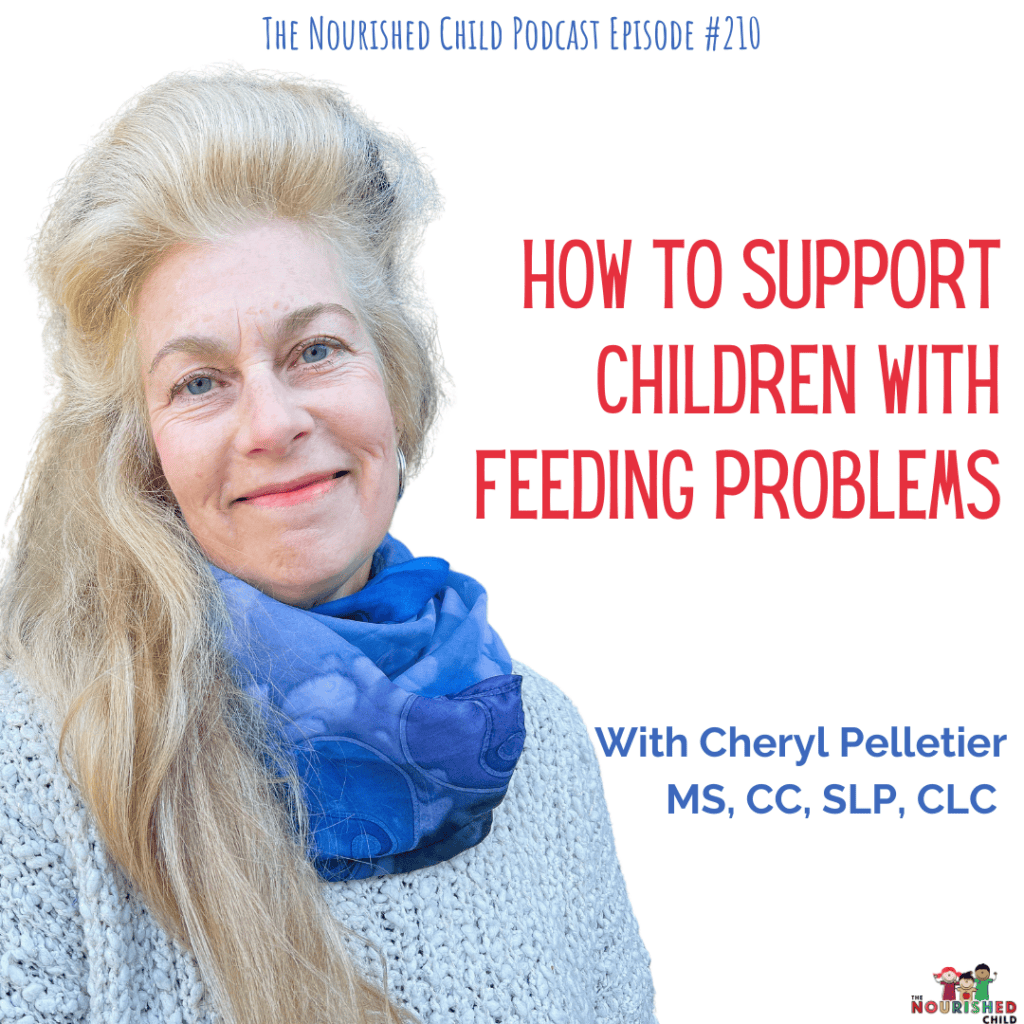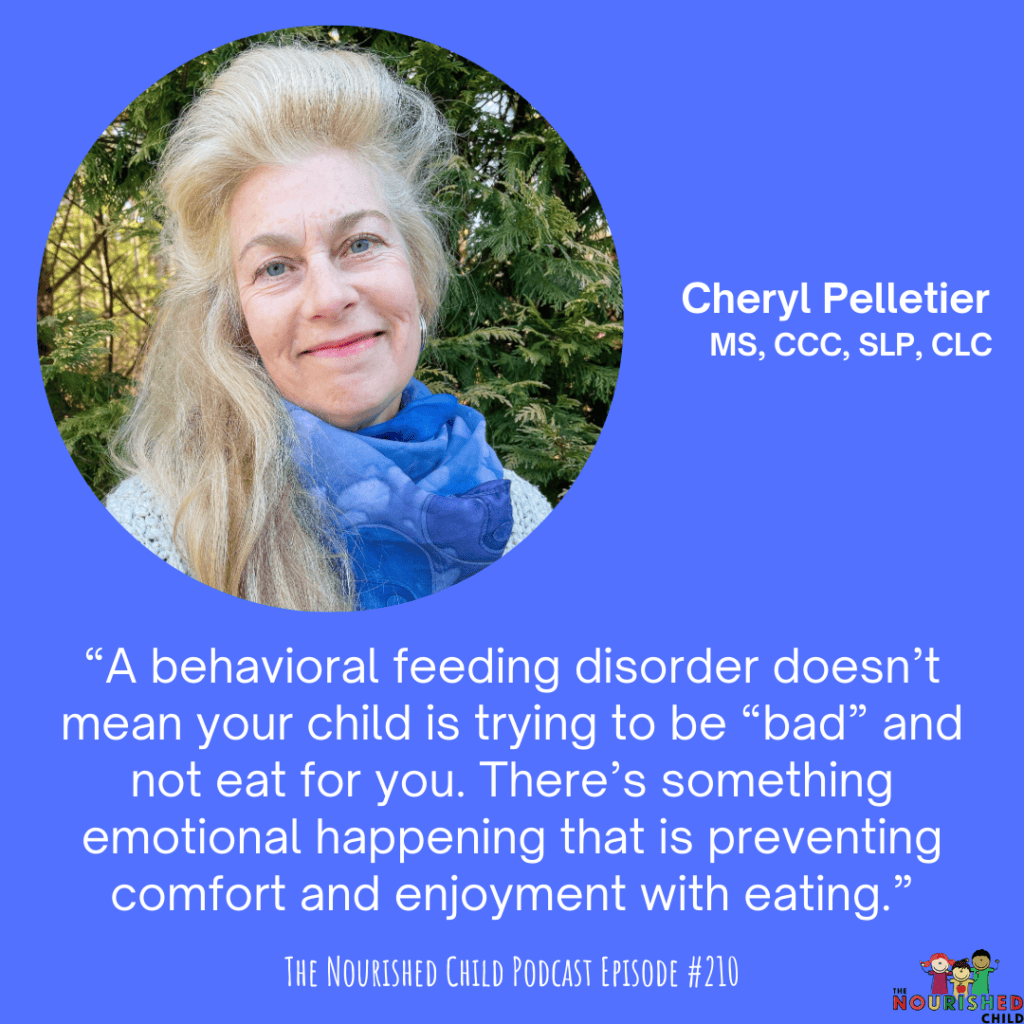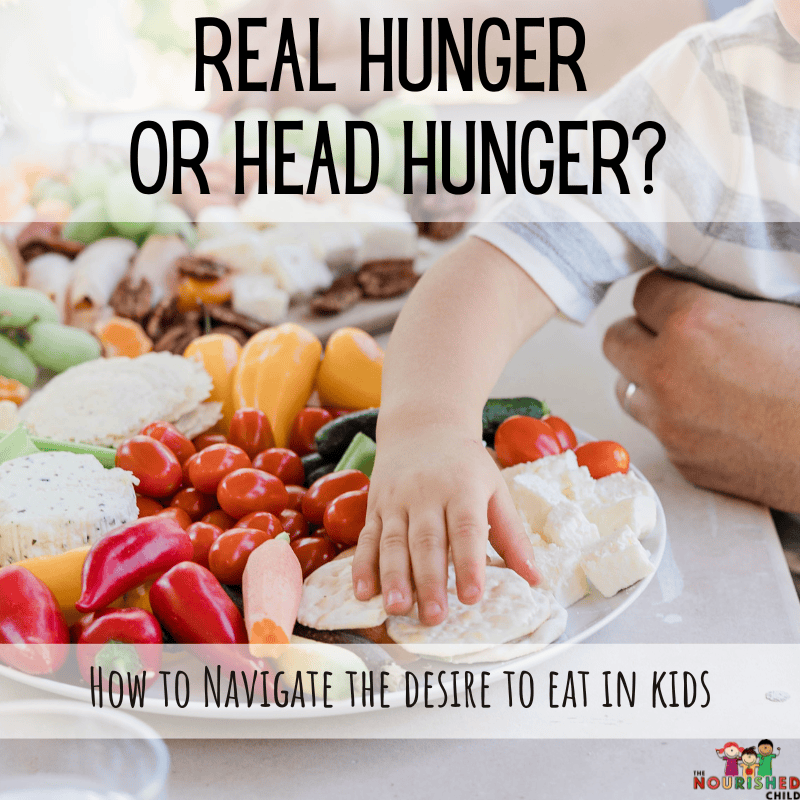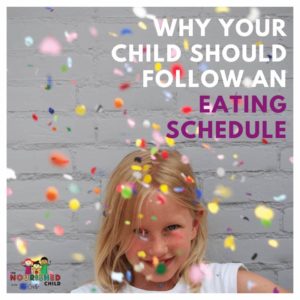Feeding Disorders in Children: Interview w/ Cheryl Pelletier
April 11, 2024
The incidence of a pediatric feeding disorder is about 20 percent in typically developing children and 80 percent in children with special needs, according to Feeding Matters.
So how do you help these children? And how can we as a team of healthcare professionals do our very best on behalf of children who need a little bit more support?
I asked Cheryl Pelletier, a speech and language pathologist specializing in pediatric feeding disorders and founder of the Side Biter, a chewing and swallowing tool, to explain when a feeding therapist can help and how to prepare to work with one.

What are some of the signs a child might have a feeding problem?
Cheryl: If a child cannot chew and swallow food efficiently, they may have a restricted diet. For instance, if they only eat mac and cheese, Ritz crackers, and two gallons of milk a day, this may point to something going on with eating and feeding.
Also, when children are slow to progress from bottle to purees to diced foods and their continuum of feeding development was interrupted somehow, perhaps by medical conditions, social, or emotional problems, or they may have learned behaviors that interfere with oral intake.
Why do speech-language pathologists get involved with feeding problems?
Cheryl: Speech pathologists are trained in all of the muscles of the face, the tongue, and the throat. We are trained in pediatric dysphagia, which is a type of swallowing disorder.
Occupational therapists may come into play when there’s more sensory barriers to eating, like a sensitivity to texture that causes young children to refuse new foods.
Are pediatric feeding disorders on the rise?
Cheryl: In the last 10 years, the actual feeding disorders in terms of chronic rejection, food phobias, refusing to sit for meals, losing weight, dropping foods that kids used to eat, all of which make kids’ nutrition so precarious, has skyrocketed.
It’s been a perfect storm. Our country just went through a major pandemic. We were just trying to survive. Many families have both parents working.
The structure of the day is different than it was even 10 years ago. Social media tells parents what they should be doing, which is quite confusing at times. That’s why a team approach is really helpful to redirect or help a family navigate a feeding difficulties.
What do you see or observe in children today that may contribute to a feeding difficulty?
Cheryl: A child who is delayed in rolling over, delayed in walking, or who has other physical delays or developmental disabilities can experience problems moving the jaw, tongue, and lips to eat enough and have stamina to swallow the foods they need to grow. This may encourage the need for a bottle for a prolonged period.
I see more children allowed to walk with food and not sit at the table. And this creates the perfect storm. When a child has a delay in oral motor skills, it may be hard for them to take a bite of meat and chew it adequately. Ritz crackers are easier to chew and faster to eat.
Some kids rely on pouches. I’m not against pouches, but they keep a child on a liquid diet. Purees are a liquid. They’re just thicker and they’re easy to offer.
Pouches often prevent the sensory experiences of eating such as smelling, touching foods, tasting and chewing-swallowing skill development from occurring, therefore kids can be behind in the skills required for eating a meal. Pouches have encouraged “snick snacking” and grazing, which interferes with the hunger dynamics.
Kids have to be hungry to be willing and able to try broccoli, or cheese and crackers, or apple and peanut butter, which all are complex foods. And so if children miss out on that window of time to chew and swallow complex foods that break apart, or are bitter or sweet, the muscles become underused. Children then may not pay attention to what their tongue and lips and jaw and mouth have to do.
Last, some kids are traumatized because maybe they weren’t paying attention and they choked on a piece of apple and then they don’t want to, or are afraid to, eat.
How does prematurity affect eating?
Cheryl: There are more children living after extreme prematurity or extreme heart defects or another medical barrier when they enter the world. These babies are not able to go right to the breast or bottle.
When there’s an interruption in the natural flow of neurological wiring, it affects learning to eat. Think about it: I’m born now, I’m hungry, I need to suck, and I need to swallow, but there’s an interruption, like an NG tube or a feeding tube in the belly (called a gastrostomy tube, or G-tube), and that is a neurological disconnect. Premature infants don’t know what to do with their mouth.
Kids that are born too early are not meant to be eating right away. This contributes to the difficulty with the whole experience of eating. Experiences are what teach us what to do. Eating is a natural thing for somebody that’s done it since they were born.
And it may be unnatural if you’re born early. When you’re born early, your lungs are immature, and you need to breathe to live. You don’t need to eat to live, because doctors and medical staff can supplement the baby with tube feedings.
Preterm infants need a good feeding team of feeding therapists and dietitians to support them with nutrition.

Do children with neuro-developmental disorders need support around eating and feeding?
Cheryl: Let’s talk about autism spectrum disorder first. Often children under age two are identified by early intervention. Families might recognize feeding difficulty or other challenges like weight loss between 12 months and 15 months. The child may be able to walk and run and can do all these things, but they’re a picky eater and don’t eat well.
That’s the first indication there may be some sensory delays. Parents may see some rigidity in the cognitive learning style of this little person. Oftentimes it’s around the first birthday when everyone’s excited the child is going to have cake. And they’ve put cake in front of them and the child tries to eat the cake but they’re gagging and the parents don’t understand why.
The child may be evaluated by an occupational therapist or a speech pathologist, and may find the child is not progressing. And from there, there might be a combination of sensory differences and the need for sameness. Some children on the spectrum really feel most comfortable when things stay the same. They don’t want to change from the bottle to a cup, or they only use one cup, or only drink one brand of milk, or only eat one brand of crackers.
Even if they used to be a good eater prior to age one, eating all fruits and vegetables, food refusal may begin. They may learn that apples are different from type to type. They are not the same.
For example, some are mealy, some are crunchy, some are sweet, some are sour, and the child is unwilling to eat them. But when food comes in a package, they know that fishy crackers are going to be the same.
In autism, it’s the attention span that’s affected. It’s challenging to focus long enough to eat.
Also, children with autism don’t like to be contained. They feel better on the move, which interrupts the routine feeding schedule we want them to have. Parents get nervous, so they give them fishy crackers and the bottle and they’re happy they ate.
ADHD is similar. Children’s minds are working fast and they have many interests. Food may get in the way. They don’t want to stop and sit down or be contained in a seat. They need the sensory support of their feet, but they may be at the age where they don’t fit in the high chair and they don’t fit in an adult chair.
That’s why we call on our friends in occupational therapy to help us with positioning and seating to minimize distraction. We also want families to model how to eat, sitting down and showing children how to use a fork or how to take a bite of chicken or pancake.
Children who are on the move won’t sit and watch their parent.
If a parents suspects their child needs feeding therapy, where do they begin?
Cheryl: First, know that you are the expert on your child. You know exactly what’s going on. The first thing I recommend is record a little data. Take a week and write down what your child actually eats. And the behaviors around eating. What is happening? Are they having trouble sitting?
Are they gagging? Are they having tantrums?
That’s one list.
Next, write down your strategies and what works and what doesn’t work. An example would be: I put out six foods that I know the child eats and I turn on their favorite Paw Patrol. I walk away and I don’t make a big deal and they seem to eat, but after a while it doesn’t work.
I know parents have tried everything. They are frustrated but it’s not their fault.
The next stop for the parent is to have a heart-to-heart conversation with the child’s health provider. Sit with the pediatrician and explain, with your notes there. Medical professionals love data.
You don’t want them to say it’s a phase or your child will eat when he’s hungry.
The strategies you’re going to learn with a skilled dietitian and a speech pathologist are things that could nip the eating challenges in the bud.
Tell your pediatrician you need help. Say, “I need you to refer me to a feeding team.”
Where can parents find a feeding team?
Cheryl: You may be able to find a feeding team in a hospital outpatient clinic, a private practice, or an early intervention program.
What does a feeding team evaluation include?
Cheryl: A team will take a look at how your child is actually chewing and swallowing. They will look at all of the barriers like an underlying medical condition that interferes with your child’s eating, body functions, or nutritional status.
Are there food allergies? Is there some constipation? Gastroesophageal reflux disease? Eosinophilic esophagitis? Extreme food selectivity?
There are lots of other things that are looked at. We’re looking to rule out problems that could manifest into why a child can’t sit or won’t eat enough food.
The team will look at a child’s medical history, behavioral problems, sensory sensitivities – the entire picture to figure out why a child isn’t eating well enough. Because children are meant to eat.
And it’s never one thing.
What are the outcomes parents can expect from working with a team of professionals to help their child with a feeding disorder?
Cheryl: When I see a family for the 1st time, I break it down into phases. We’re going to use the power of three. We’re going to take three months to investigate and to see what will work and the underlying barriers to eating.
During this first phase, I want to make things calmer and happier in your home. That could include some stress reduction, could be adding some cooking activities, or making friends with foods. As far as chewing and swallowing problems, we may want to go back to textures that might be helpful to then learn forward.
We’re not going to push too hard. It’s going to be relaxed. Anytime you try to change things, it takes a couple of months.
Your child and your family have been invested in the style of eating for many, many months. So, there’s no quick fix.
So the next three months is really identifying those barriers. Maybe they need some medicine to help them to toilet better. Or some sensory support or behavioral support. Maybe they need a dietitian to sit down and come up with a meal plan and supplements to help the child be better nourished and feel better.
Maybe they don’t need speech therapy right away. Maybe they need a neurological workup to find out if there’s a syndrome. This is the time when we see things and now we take care of them.
At the same time, we’re moving into the strategies we know as a feeding and swallowing therapist that help right away. Changes in textures. Advancing food exposures, positioning at the table, changing the environment, or removing the toys. There’s just a lot of things that we can do to support learning and building a new routine.
Can parents expect their children will overcome these feeding barriers?
Cheryl: Kids and families make so much progress, especially when they have an open mind.
Families might need doses of feeding therapy. I dose out what the support needs to look like. It could be twice weekly, once a month, or it can increase or decrease based on the child’s progress.
What is a behavioral feeding disorder?
Cheryl: This diagnosis doesn’t mean your child is thinking in their head, ‘I am going to be a bad boy and I’m not going to eat for you.’ That’s not what it means. It means there’s something emotional happening that’s preventing the child from enjoying eating or feeling comfortable.
We want to build comfort around food for so many reasons. Food comfort translates to a lifetime of being able to go to a wedding or to a birthday party and partaking in what other people are eating and enjoying the meal together.
If you’re not comfortable and you don’t go to any of these things, it puts you, again, at another barrier. That’s the whole idea behind the team and the process. Some kids need more time.
Learn more from Cheryl in our podcast interview which can also be watched on video!










